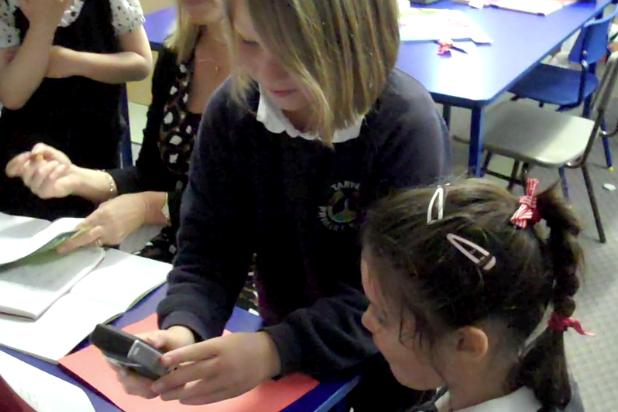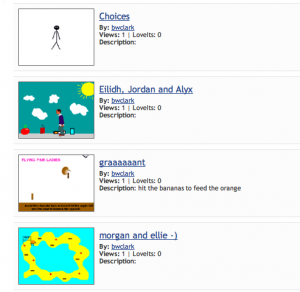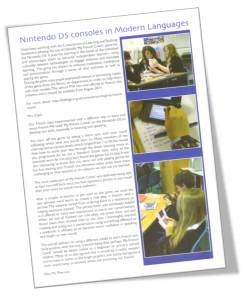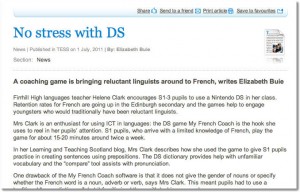

Consolarium blog
 Stop-motion animation used to be something that seemed unattainable to me. I remember many years ago watching movies that my uncle had made that had a number of toy cars and trains moving in a orchestrated fashion. Although I now know that he had been using the technique of stop-motion animation at the time I was in awe of the fact that there were no hands helping to move these toys and props… this was a strange magic! I didn’t realise that this was the same technique that was being used in many children’s TV programmes such as Bagpuss, Trumpton and movies such as King Kong (1933). A few years later stop-motion animation came very much to the fore in my generation’s TV viewing experience when Morph made his appearance on Take Hart. It was amazing to see such entertainment and life come to our screens from a simple ball of plasticene.
Stop-motion animation used to be something that seemed unattainable to me. I remember many years ago watching movies that my uncle had made that had a number of toy cars and trains moving in a orchestrated fashion. Although I now know that he had been using the technique of stop-motion animation at the time I was in awe of the fact that there were no hands helping to move these toys and props… this was a strange magic! I didn’t realise that this was the same technique that was being used in many children’s TV programmes such as Bagpuss, Trumpton and movies such as King Kong (1933). A few years later stop-motion animation came very much to the fore in my generation’s TV viewing experience when Morph made his appearance on Take Hart. It was amazing to see such entertainment and life come to our screens from a simple ball of plasticene.
When I was ‘Doon in the Wee Room’ recently in Tarves PS I saw this very same entertainment, life AND learning in evidence as some P.2/3 children were making their own stop-motion animation using a basic set that they had made, stop-motion animation software, a digital camera and some plasticene. In my discussion with the class teacher I had learned that this activity had arisen as a result of a discussion with the children about 3D shape. One child had made a sphere out of plasticene but had then cut out a mouth and made the sphere talk. This led to an idea to create an animation all about 3D shape and then their subsequent attempts to bring it to life…
In relation to Curriculum for Excellence it is clear that Technologies TCH 1-04b is being addressed here but the main focus of this learning activity is embedded in Mathematics, namely a focus on 3D Shape MTH1-16a. We can also see from the video how the children are working effectively together to make this project work. Even more importantly in my view is that from this early stage in this classroom these children are being given the framework of opportunities to engage with contexts for learning where they can use digital technologies to create and not just consume. How can such positive attitudes, embedded in their perceptions of themselves as learners, at this stage of their development influence and inform these children’s expectations of themselves, their developing skill-sets and ways in which they can apply these across the range of learning experiences that they will encounter? This can only be good for learners.
The challenge for us all in education is to ensure that we continue to offer such challenging and rich learning environments and experiences where our children can show us just what they can do.
More
In Scotland as in many countries throughout the world, active learning is seen as an appropriate way for children and young people to develop vital skills and knowledge and a positive attitude to learning. In order for active learning to be embedded in environments that offer challenge, demand and appeal we must have teachers and support staff who are well informed and skilled enough in all requisite areas to be able to do this. This series of three blogposts will feature a teacher from Tarves PS in Aberdeenshire who has made great efforts to embed technologies into the life and learning of his classroom so that they can play an active, purposeful and integral part in his pupil’s learning experiences.
Jonathan Cordiner
Having spent 2 years on secondment as a member of the Glow Development team in Aberdeenshire Jonathan Cordiner was keen to return to class so that he could apply, in his own practice, the range of resources and approaches to learning that he had been promoting in his Development Officer role.
On a recent visit to Aberdeenshire it was recommended that I pay a visit to Jonathan’s class to see just how he had been making progress with embedding technologies in to the life and learning of his class. Having worked with him before on some GBL related initiatives I fully expected to see some good practice particularly in view of the high standard and high aspirational levels that he and the team in Glow team in Aberdeenshire attained. On arrival at the school I was welcomed with a wonderfully happy chorus of that great Scottish folk song - Doon in the Wee Room. It set the tone for our visit because it was obvious that everyone is happy, everyone is there, and we’re a’ makin’ merry each in his chair, doon in the wee room underneath the stair.
It was also immediately obvious that the high standards he had been used to in his development role had been maintained and that technology was something that the children in his P2/3 class were more than used to. I saw technology purposefully embedded across a range of contexts that included his pupils:
 The level of competence and confidence in the use of a range of technologies displayed by the children exemplified just how a thoughtful and skilled teacher can create the active, purposeful and challenging environment that children can thrive in. You can clearly see this as you watch the video that is embedded in this post and as you do please reflect on just how at ease the children are with the technologies that you see them using. How far down the road of developing and attaining CfE outcomes such as TCH 1-03a, TCH 1-04a & TCH 1-04b do you think these children are?
The level of competence and confidence in the use of a range of technologies displayed by the children exemplified just how a thoughtful and skilled teacher can create the active, purposeful and challenging environment that children can thrive in. You can clearly see this as you watch the video that is embedded in this post and as you do please reflect on just how at ease the children are with the technologies that you see them using. How far down the road of developing and attaining CfE outcomes such as TCH 1-03a, TCH 1-04a & TCH 1-04b do you think these children are?
If there had been more time then the aspects of CfE that were linked to the wider learning experiences in which the Technology use was embedded could have been teased out a bit more because it is clear from what I saw that Technologies were seamlessly woven in to the fabric of learning in this classroom.
Mr Cordiner’s class has since moved on to their next challenge with Technologies by making their own computer games with 2DIY. You can view some of these in their class Glow group.
What an experience these pupils are having ‘Doon in the Wee Room‘ at Tarves School. Isn’t this what school should be about? I am very pleased to say that in my experience in visiting schools throughout Scotland that there are very many teachers like Mr Cordiner who are embedding this level of challenge, demand and expectation in all aspects of learning but who are also effectively embedding technologies in and across learning.
Thank you to all at Tarves PS for sharing their great work and for making me so welcome.
MoreOn the last Tuesday of the term, I was able to talk with pupils from Loriston and Kirkhill primary schools over Glow Meet about their P7-S1 transition project. Along with Charleston and Abbotswell primary schools, all primary 7 pupils studied Healthy Living as the basis of a transition project to Kincorth Academy. This is a little taster of what went on during the project. You will be able to find out more at SLF 2011 on Thursday 22 September, 1.15pm at this seminar.
Using a dedicated glow group, pupils from all schools were asked to design and upload a flyer to promote healthy living to a document store. All pupils had access to these stores and were encouraged to look at others work and leave comments. However, flyers were not the only media that the pupils created and shared.
My ex Consolarium colleague, Charlie Love, spent time with all 4 primary schools, giving them all an overview and a few lessons on using Scratch to create games. They also used the tutorials available in the Consolarium Glow Group, as well as looked at remixing projects from the Scratch website.
The pupils were incredibly motivated and challenged by the this activity and they told me in the meeting that while it was hard to do the programming, they worked through the problems as groups. If they couldn’t find a solution, they used a forum within Glow to ask for help / get feedback from their classmates / peers in another school / a teacher.
These games were also uploaded to the Glow group for feedback from other schools. One of the boys in Kirkhill primary school told me that the feedback he got back via glow helped him make his game more playable. This was echoed by pupils at Loriston primary school.
 All pupils found the the online community a valuable source of help and feedback, but would of liked to have Mr Love there in person more often to help out with any problems they had. However, by not having he expert on hand, meant the the pupils did have to seek alternative help. As well as the online Glow community, in many cases, some pupils who really got into the game design / scratch projects, became the in-class expert that many pupils turned to for help.
All pupils found the the online community a valuable source of help and feedback, but would of liked to have Mr Love there in person more often to help out with any problems they had. However, by not having he expert on hand, meant the the pupils did have to seek alternative help. As well as the online Glow community, in many cases, some pupils who really got into the game design / scratch projects, became the in-class expert that many pupils turned to for help.
You can play some of the games online at the Scratch website here, or, if you have a Glow account, visit the glow group and see all games and flyers here.
Within the group, pupils from P7 and the secondary schools were encouraged to use a forum to discuss any questions / fears they may have about coming up to the Academy as well as seek help with their Scratch Projects.
You can find out more about this transition project, its links to CfE, use of Glow and their first experience of Game Design at SLF 2011 - sign up here.
More So, it’s the end of the school year and Modern Foreign Language pupils at Firrhill High School in Edinburgh have been reflecting on the use of My French Coach on the Nintendo DS in their French lessons. One of the pupils, wrote about her and her classmates experience of the DS in the school magazine, Firrhill Heights.
So, it’s the end of the school year and Modern Foreign Language pupils at Firrhill High School in Edinburgh have been reflecting on the use of My French Coach on the Nintendo DS in their French lessons. One of the pupils, wrote about her and her classmates experience of the DS in the school magazine, Firrhill Heights.
You can read her article here.
 Helene Clark, the languages teacher who lead the project is delighted with the impact the game has had on her pupils learning and spoke to Elizabeth Buie at the TES about her experience. You can read the article here.
Helene Clark, the languages teacher who lead the project is delighted with the impact the game has had on her pupils learning and spoke to Elizabeth Buie at the TES about her experience. You can read the article here.
As a result of the project, Helene submitted a proposal for funding from the PTA at the school in order to buy language based DS games, and other games the Consolarium have used in the past, to be kept in the school library for pupils to borrow in order to improve their French, or indeed get a taster of a new language. Helene stated:
I managed to purchase 14 games for our school library, as well as 2 DS consoles. The idea is that children will be able to borrow the games as they can borrow books to practice French, German, Spanish and Mandarin at their leisure. I have also purchased a couple of “My Word coach” and “Brain Training” games to show that some games can be used to support literacy and numeracy.
The My French Coach games for the DS have been discontinued, however, Ubisoft have made the game (and others) available on the iPod touch / iPad at a cost of £2.99 from the AppStore, thus making it even more accessible to pupils / departments who have these devices.
More
Find us on